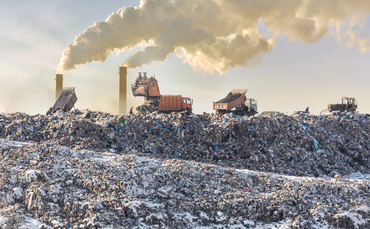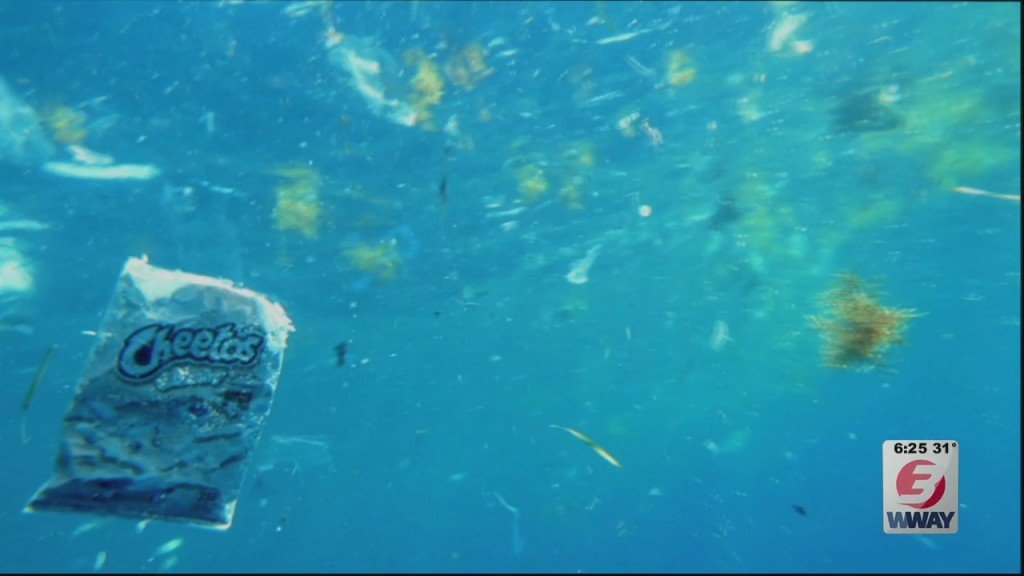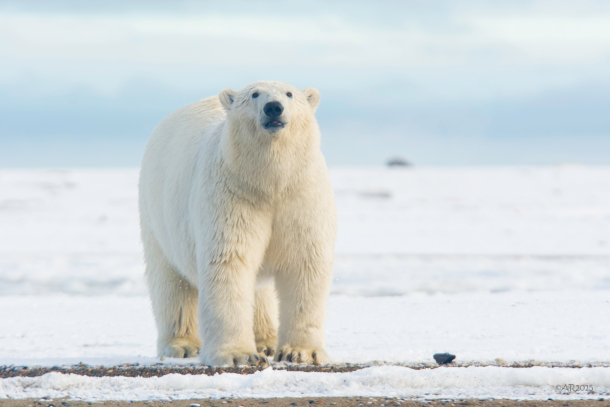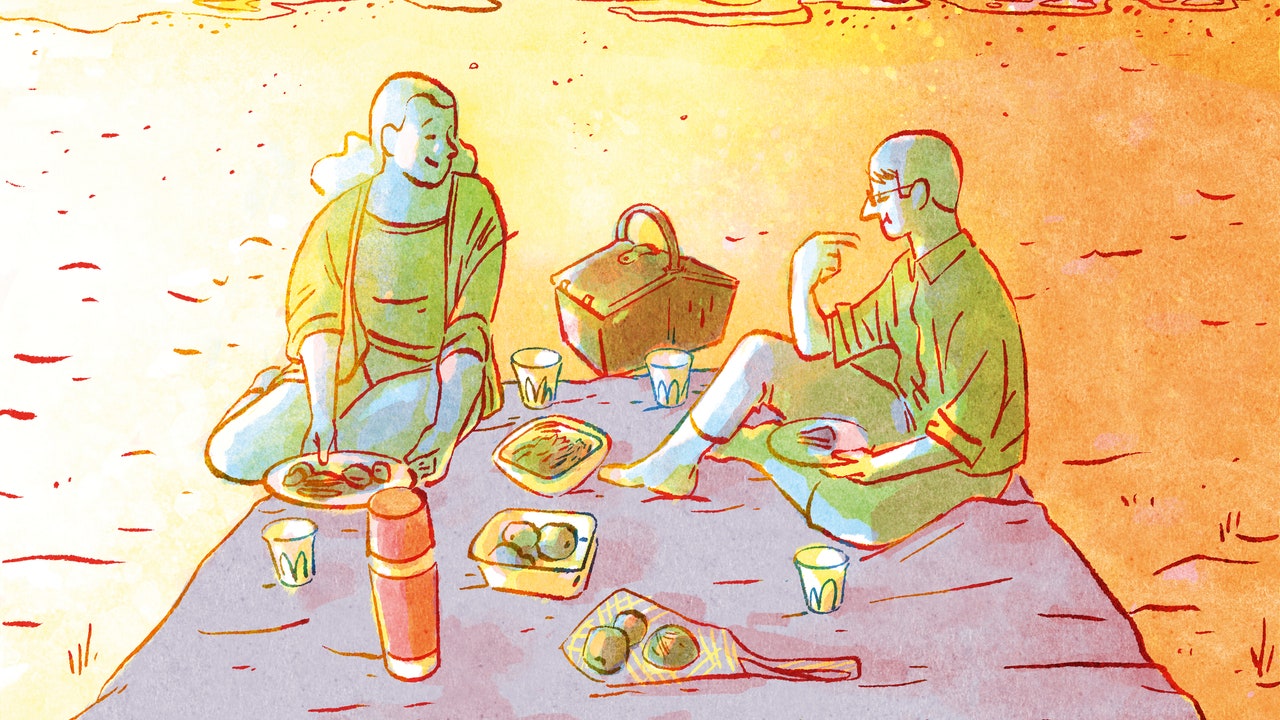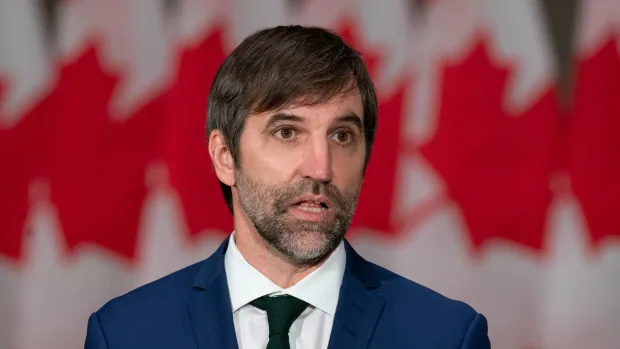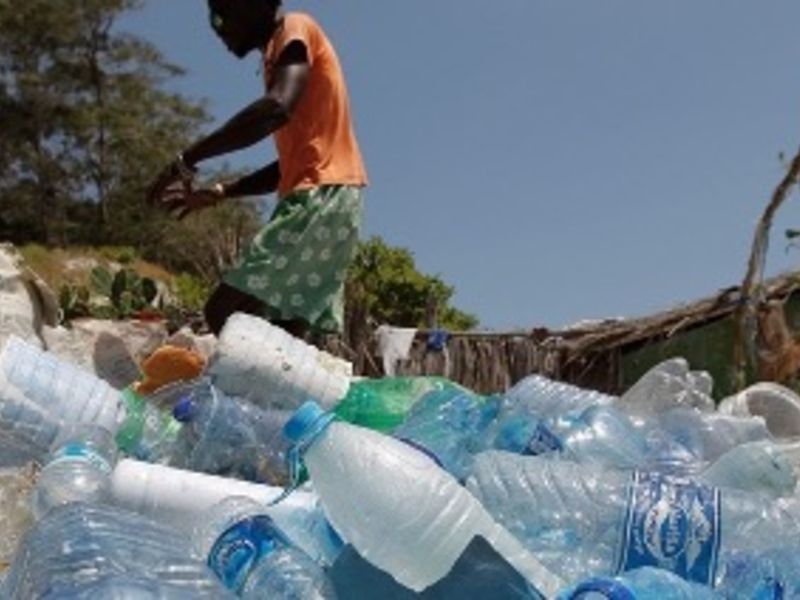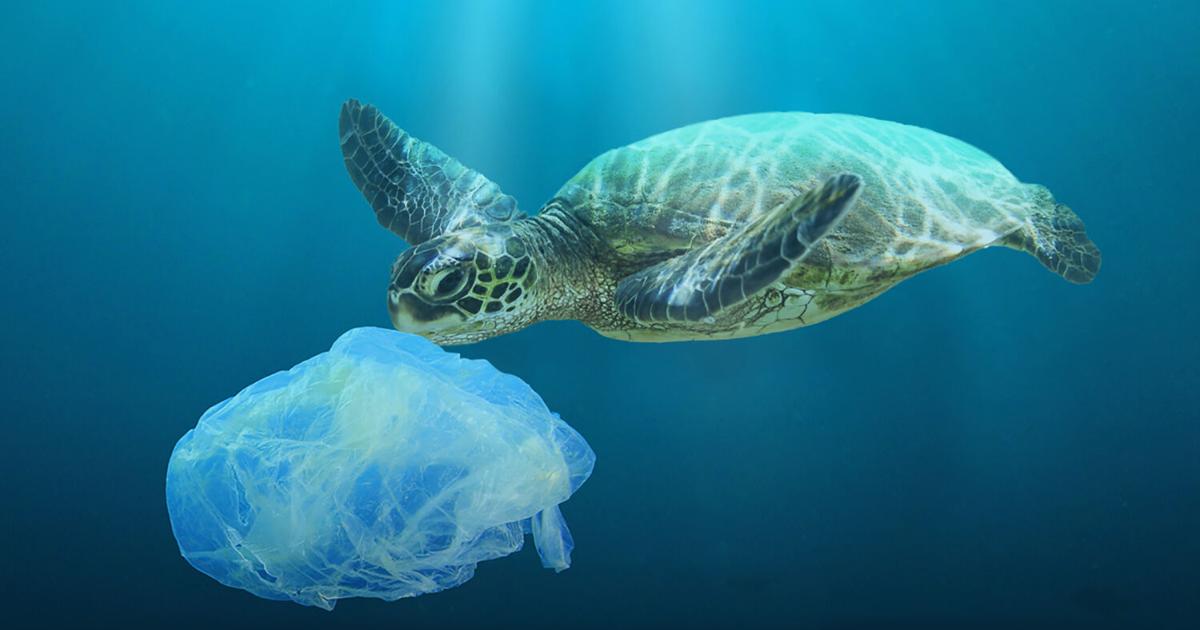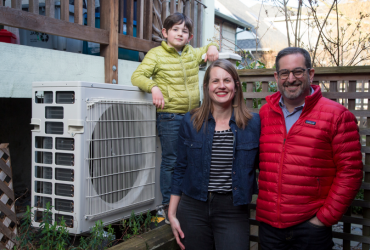Calls are growing for nations to sign an historic global treaty to tackle plastic pollution at a UN Environment Assembly conference due to take place in Nairobi this Spring.
In a new report published this morning, the Environmental Investigation Agency urged officials attending the talks to develop an ambitious international agreement to crackdown on plastic pollution that covers the whole lifecycle of plastics, from production through to waste management.
Dubbed Connecting the Dots: Plastic pollution and the planetary emergency, the report argues that plastic pollution must be treated alongside biodiversity loss and climate change as a planetary emergency. Plastic pollution is set to triple by 2040, it notes, with the weight of plastic in the seas by that date estimated to be on track to exceed that of all the fish in the ocean.
“There is a deadly ticking clock counting swiftly down,” said EIA Ocean Campaigner Tom Gammage. “The damage done by rampant overproduction of virgin plastics and their lifecycle is irreversible – this is a threat to human civilisation and the planet’s basic ability to maintain a habitable environment.”
Discussions about a global pact to cut plastic pollution are expected to dominate the agenda of a UN Environment Assembly 5.2 (UNEA 5.2) conference in April.
While more than two thirds of UN member states have said they support a treaty on plastic pollution, it remains unclear whether any pact will target the production of plastics, an intervention that is like to face major pushback from oil and gas and chemicals firms, as well as countries that export plastic.
The EIA has warned that decision makers attending the conference should move away from a “reductionist litter focus” and instead adopt a full lifecycle approach that tackles all aspects of plastic pollution, from production through to product design and waste management.
The report is published on the same day that more than 70 companies signed an open letter calling for a treaty on plastic pollution that includes “both upstream and downstream policies”.
Among the signatories to the letter are Coca-Cola, Nestle, and PepsiCo, the consumer goods giants that have been identified as the world’s top plastic polluters for three years running by the Break Free From Plastic Campaign.
Other consumer goods brands and retailers to have signed the letter include Mars, P&G, Unilever, Mondelez International, Ikea, Walmart, and Danone, alongside a raft of financial institutions, such as Federated Hermes, BNP Paribas Asset Management, Armundi Asset Management, and Robeco.
“We are at a critical point in time to establish an ambitious UN treaty that fosters collaboration for systemic solutions and speeds up the transition to a circular economy globally,” the letter states. “UNEA 5.2 is the decisive, most auspicious moment to turn the tide on the global plastic pollution crisis. We cannot afford to miss it.”
Category Archives: Ocean
South Coast researcher leads effort to ease ocean pollution by using microbes to decompose plastics
Our beautiful oceans are facing a very ugly problem.The world is producing about 300 million tons of plastics a year. Of that, an estimated 14 million tons is ending up in our oceans. And, experts say plastics make up about 80% of all ocean pollution.”There are plastic materials that wouldn’t degrade in the oceans over thousands of years,” said UC Santa Barbara marine microbiologist Alyson Santoro.She is leading a team of researchers looking at a novel solution: using nature to help create biodegradable plastics.”There’s actually bacteria that has evolved a way to break that down, and they naturally occur in the oceans,” said Santoro. “What we’re trying to do is figure out what things those microbes might need to help break down those plastics faster.”Santoro is a Marine Microbiologist in UCSB’s Department of Ecology, Evolution, and Marine Biology. The National Science Foundation has funded a project to start exploration of the concept.The initial effort is looking at a specific type of plastics ocean pollution, which can be used to test the concept. They’ll work with people who manufacture oceanographic sensors, devices used for things like monitoring ocean temperature. It’s more expensive to go out and retrieve the sensors than to deploy new ones. Lots of them get deployed, but are never recovered.Santoro hopes the initial research will help demonstrate the feasibility of the concept, and set the stage for expanded research.The UCSB researcher feels there’s no question the concept will work, and can help ease the global ocean plastics pollution problem. She thinks the real questions are around developing a balance which allows the plastics to do their intended job without existing on for years, or even decades.While it’s just research at this point, the team is hoping that what they are working on could help lead to solutions to a growing global pollution crisis.
Plastic Ocean Project working to protect biodiversity of the Carolina coastline from plastic pollution
January 4, 2022
WILMINGTON, NC (WWAY) — From birds to fish, plastics floating in the water kill millions of animals annually.
Plastic Ocean Project (POP) is a nonprofit that tries to create awareness about plastics in our oceans and they’re hosting a fundraiser later this month at the N.C. Aquarium at Fort Fisher.
According to the organization’s website, the nonprofit’s mission is to educate through field research, implement progressive outreach initiatives, and incubate solutions to address the global plastic pollution problem, working with and for the next generation to create a more sustainable future.
“We work closely with universities as well the community on how to reduce waste in our environment as well as come up with solutions to diverting those plastics from those environments,” said POP Executive Director Bonnie Monteleone.
The organization is hosting a fundraiser called “For the Ocean Gala” from 6:30-9:30 p.m. on Jan. 29 at the NC Aquarium at Fort Fisher.
“This is an opportunity for us to bring people out to learn more about POP as well as a film project we’re working on called ‘If the Ocean Could Talk: A voice for the North Atlantic,’” Monteleone said.
During the gala, POP will show a trailer for the documentary called “Save the Whales 2.0.” They’re also hoping to solicit sponsors and supporters to contribute financially to the project.
Monteleone says many documentaries don’t address the issue of plastic pollution.
“So we decided to take that on ourselves, to create the film so we could educate people that the problem isn’t over in the Pacific but it’s also here in the Atlantic,” she said.
North Carolina has more than 322 miles of ocean shoreline and is one of the most biodiverse locations in the world.
“When we think about plastics having a negative impact on the marine environment and then the abundant biodiversity that we have here, it made perfect sense for us to start educating people,” she said. “We really should start taking care of the north Atlantic as well.”
Monteleone says there’s a growing body of research that supports the critical role whales play in the health of our oceans.
“Without the whales, we lose the phytoplankton that actually exchanges co2 into oxygen,” she said. “It really behooves us to start taking care of these whale populations because the more we lose those, the more we lose the biggest defense we have against climate change.”
If we fail to protect the habitat for whales and other sea life, Monteleone says it will create a domino effect of negative impacts.
“We’re the ones causing the problem,” and she added, “we’re the ones who can solve it.”
When attendees of the gala watch the ‘Save the Whales 2.0’ trailer, Monteleone says it will them a sense of hope.
“There are plenty of industries as well as nonprofit organizations and educators that are taking this issue head on, and so we’re going to be putting a big spotlight on the hope and what each and everyone of us can do to help save the whales,” she said.
The “For the Ocean Gala” takes place Saturday, Jan. 29, from 6:30-9:30 p.m. at the North Carolina Aquarium at Fort Fisher. Click here for ticket information.
Categories: Brunswick, Carolinas, Local, NC, NC-Carolinas, New Hanover, News, Pender, SC, Top Stories, World
Living on Earth: Beyond the Headlines
Air Date: Week of January 7, 2022
stream/download this segment as an MP3 file
Polar bears are one of several Arctic species that would be threatened by oil and gas drilling exploration projects in the Strategic Petroleum Reserve near the Arctic National Wildlife Reserve. (Photo: Anita Ritenour, Flickr, CC BY 2.0)
This week, Environmental Health News Editor Peter Dykstra and Host Steve Curwood discuss an oil and gas project in a region adjacent to the Arctic National Wildlife Reserve that could threaten polar bears and the planet. Also, some good news for the planet as France bans many kinds of plastic packaging for fresh produce. And they take a look back in history to President Eisenhower’s 1955 proposal of the Interstate Highway System.
Transcript
CURWOOD: It’s Living on Earth. I’m Steve Curwood. And on the line now from Atlanta, Georgia for our customary look beyond the headlines is Peter Dykstra. Peter is an editor with environmental health news that’s ehn.org and dailyclimate.org. Hi there, Peter. Happy New Year!
DYKSTRA: Happy New Year, Steve. And we’ve got some news about polar bears, among other thing polar bears have become perhaps the enduring symbol of what climate change can do, is doing, to the Arctic. Just before Christmas, the Center for Biological Diversity announced a federal lawsuit against the Interior Department over a massive oil and gas exploration project within the Strategic Petroleum Reserve in the North Slope of Alaska.
CURWOOD: Well, that petroleum was right next to the Arctic National Wildlife Refuge, and is almost as big and has many of the species that are protected next door there. And currently, it’s free from oil and gas development.
DYKSTRA: That’s right, the Peregrin exploration program would be a five year, almost year-round oil and gas effort, to see whether there is extractable oil and gas in a portion of the reserve. The Trump administration okayed the exploration, Biden’s Interior Department would have to okay, the permanent oil and gas drilling there. But if it happened, it’s hard to see that there wouldn’t be the same kind of sizable damage that we fought over in the Arctic National Wildlife drilling proposals for the last 40 years.
CURWOOD: Of course, one of the concerns even about exploration is that it involves building snow and ice roads and air strips in areas where the permafrost itself, if it’s disturbed, could become a source of methane and other gases for climate disruption.
DYKSTRA: That’s right, noise pollution from all of that industrial activity is going to add to the burden of an area that has so far been pristine.
CURWOOD: And of course, the big question is, do we really need all this oil at a time of the climate emergency so maybe this lawsuit to protect the polar bears is really designed to protect us.
DYKSTRA: There’s a 60 day comment period on the potential filing of the suit. Once that comment period ends in a couple of months, keep you posted on what happens with the proposal to drill in the Strategic Petroleum Reserve.
CURWOOD: Okay, Peter, well, tell me what else do you have for us today?
DYKSTRA: A little good news. If you’re concerned about plastic pollution in the world, after climate change, it’s arguably the biggest worry for the environment and growing very quickly. But France has banned the use of plastics for in packaging, most fruit and vegetables. The ban came into effect the first of the year, under the new rules, everything from onions, carrots, tomatoes, potatoes, apples, pears, and about 30 other produce items can no longer be sold, wrapped in plastic. Instead, they should be wrapped at all in recyclable materials.
France has placed a ban on selling certain fruits and vegetables in plastic packaging as part of their process to phase out all single-use plastics by 2040. (Photo: Marco Verch Professional Photographer, Flickr, CC BY 2.0)
CURWOOD: Well, that’ll be helpful because plastic pollution, as you say, is a major threat not just in the ocean, but to human health when it’s used to wrap food because of chemicals that some food wrappings can contain.
DYKSTRA: That’s right and foot in the door in France, so to speak, is hoped to be the first step for all of the EU nations to take in the effort to curb plastic pollution.
CURWOOD: Wouldn’t it be nice that the United States thought the same way.
DYKSTRA: Wouldn’t it be nice?
CURWOOD: Hey, Peter, take a look back in the history books. Tell me what you see.
DYKSTRA: Back in 1955, the first week of the year. And his State of the Union address President Eisenhower proposed the Interstate Highway System, which somewhat ironically, was based on what I saw in World War II, when Hitler guided the creation of the Autobahn system in Germany, not primarily seen as a way for Germans to zip across the country and leisure, but a way for German armaments and soldiers to zip across the country. In World War II, I’d wanted the same kind of mobility for the United States at a time when we were in the middle of the Cold War with Russia.
This photo from 1993 shows a ceremony unveiling the designs for the commemorative signs marking a highway as being part of Eisenhower’s Interstate System. L-R Chairman Nick J. Rahall (D-WV) of the House Surface Transportation Subcommittee, John Eisenhower (President Eisenhower’s son), Federal Highway Administrator Rodney E. Slater, and Chairman Norman Y. Mineta (D-CA) of the House Committee on Public Works and Transportation. (Photo: Federal Highway Administration, Wikimedia Commons, Public Domain)
CURWOOD: So 65 years later, they’re still building parts of the interstate system. Peter, right?
DYKSTRA: That’s right and the interstate system, parts of it that are 65 years old or close to it are falling apart, which is a part of the infrastructure effort now underway in Washington.
CURWOOD: Thanks, Peter. Peter Dykstra is an editor with environmental health news at ehn.org and dailyclimate.org. We’ll talk again real soon.
DYKSTRA: All right, Steve, thanks a lot. Talk to you soon.
CURWOOD: And there’s more on these stories on the living on Earth website, that’s loe.org.
Links
The Center for Biological Diversity | “Lawsuit Launched to Protect Polar Bears from Arctic Oil Exploration” The Guardian | “That’s a Wrap: French Plastic Packaging Ban for Fruit and Veg Begins” Read President Eisenhower’s State of the Union Address from 1955 here
A global treaty can turn the tide on ocean waste
In mid-2020, as the world’s attention was focused on tackling the Covid-19 pandemic, the scale of another pressing global challenge – plastic waste and pollution – was being quantified in one of the most analytically robust studies ever produced on ocean plastics. Breaking the Plastic Wave, produced by The Pew Charitable Trusts and SystemIQ, paints a bleak picture of 2040, when it projects ocean plastic stocks will have reached over 600 million tonnes due to increased production and insufficient collection infrastructure. This vision of the future doesn’t have to become reality. In 2022, governments around the world will come together to create a binding global treaty to address plastic waste and pollution at its source.Support for such a treaty has already been expressed by leading businesses, financial institutions, national governments, and more than two million people via a public petition. A plastic treaty could have as big an impact as the Montreal protocol that has led to the gradual repair of the ozone layer.Many businesses and governments have set ambitious targets and taken action to address plastic waste and pollution, not least through the Ellen MacArthur Foundation’s Global Commitment and Plastics Pact network. These two initiatives alone unite more than 1,000 organisations behind a common vision of a circular economy for plastic, in which all the plastic items we don’t need are eliminated, the ones we do need are designed for reuse, recycling or composting, and those that we use are kept in the economy and out of the environment.Initiatives such as this have begun to deliver change among market leaders. Their use of recycled content in plastic packaging is increasing and these companies have committed to significantly reduce use of virgin plastics by 2025. This means that fossil resources are being left in the ground, and plastic is being used again and again. Some big businesses have also piloted successful packaging-reuse models. This includes Danone, which is working closely with Loop by Terracycle to provide some of its food products in returnable jars, and Unilever, which is trialling “refill on the go” for washing-up liquid and detergent in Chile, and for its Sedal shampoo brand in Mexico.However, voluntary commitments can only do so much. To scale these efforts globally and across industries in order to end to plastic waste and pollution, more organisations must take urgent action.Building on important work carried out under the Canadian G7 and Japanese G20 presidencies in 2021, the G20 agreed to engage fully in upcoming UN discussions on how to take further decisive measures. A treaty is the next necessary step and will provide the framework for building capabilities and institutional mechanisms, and for increased international co-ordination to solve this crisis. As a global policy framework, it will underpin sectoral, regional and national action plans, and support implementation.The beginnings of a global treaty in 2022 will harmonise policy efforts, enhance investment planning, and stimulate innovation and infrastructure development for a world free of plastic pollution.Get more expert predictions for the year ahead. The WIRED World in 2022 features intelligence and need-to-know insights sourced from the smartest minds in the WIRED network. Available now on newsstands, as a digital download, or you can order your copy online.More Great WIRED Stories
Canada moving to ban plastic straws, bags by end of 2022: Guilbeault
It’s the end of days for plastic grocery bags and Styrofoam takeout containers in Canada, but the products can still be manufactured for export.Environment Minister Steven Guilbeault published draft regulations Tuesday outlining how Canada will ban the manufacture, sale and import of these items, along with plastic cutlery, stir sticks, straws and six-pack rings, by the end of next year. The regulations outline how each of the products is to be defined; plastics bags for example are those made of plastic film which will break or tear if used to carry 10 kilograms over a certain distance. Cutlery includes forks, knives, spoons, sporks and chopsticks that will start to melt if immersed in hot but not boiling water. There are some exceptions for single-use plastic flexible straws to accommodate people with disabilities and those needing them for medical purposes. The public can provide written comment on the draft regulations until March 5, and the timing of the final regulations will depend on how much feedback is received. World Trade Organization rules mean Canada has to allow a six-month phase-in period once the final regulations are published, but Guilbeault said he expects them to take effect by the end of 2022. He said the ban is only part of the story because what isn’t being banned has got to be recycled. “I mean, rightly so, a lot of people are focusing on the ban and that’s important,” he said. “But one of the bigger challenges we have is to get our house in order when it comes to recycling.” A 2019 Deloitte report commissioned by Environment and Climate Change Canada said 3.3 million tonnes of plastic waste was tossed in 2016 and less than one-tenth of it was recycled. Environmental groups urge further action There were then only 12 recycling companies nationwide. Canada set a target to recycle 90 per cent of plastic waste by 2030 and Guilbeault said there is work underway to standardize and co-ordinate recycling across provinces. Standards for plastics to make them easier to recycle, as well as a requirement that half of all plastic packaging must be made of recycled material, are also coming, he said. In 2016, almost 30,000 tonnes of waste ended up in the environment, polluting rivers, beaches and forests with discarded coffee cups, water bottles, grocery bags and food wrappers. “People are tired of seeing this litter in our streets and I think some of the powerful images we’ve seen around the world of plastic waste affecting our ecosystem has really gotten to people,” Guilbeault added. “So they want us to move and we’re moving.” Sarah King, head of Greenpeace Canada’s oceans and plastics campaign, said the government is moving too slowly and isn’t going far enough. King wanted to see all single-use plastics banned, including plastic bottles, cigarette filters, coffee cups and food wrappers. With every day the government stalls, we are missing an opportunity to halt tonnes of plastic pollution from being dumped in the environment.- Gretchen Fitzgerald, Sierra Club of Canada Foundation “Canadians have been waiting a long time for the federal government to take strong and urgent action to tackle plastic waste and pollution and these regulations definitely don’t reflect that call to action,” she said. King said the government also needs to focus its energy and money on transitioning from single use and recycling to reuse and refill strategies. Environmental Defence, a Canadian advocacy group, welcomes the ban generally, but has concerns about the export of plastics. “The government must ban their manufacture for export or Canadian-made single-use plastic products will continue to pollute other countries,” Karen Wirsig, Environmental Defence’s plastic programs manager, said in a statement. “The government also needs to expand the list of banned single-use plastics, including hot and cold drink cups and lids, which are consistently found littered in the environment,” the statement reads. A federal government assessment on plastic pollution in 2020 reported that 77 per cent of the 4,800 kilotonnes of plastic polymers produced in Canada in 2016 were exported. “The government has determined, through thorough analysis, that prohibiting single-use plastics manufactured or imported for export would not lead to a global reduction in plastics,” a spokesperson for Guilbeault’s office told CBC News. “Rather, global demand would likely be met by businesses in countries that still allow for export.” “Minister Guilbeault’s mandate letter is clear about working with other countries to develop a global agreement on plastics that would target this issue more comprehensively,” the spokesperson added. The Sierra Club Canada Foundation, another environmental advocacy group, welcomed the news, but said it too wants to see the ban expanded. “We also need to expand this ban to include all unnecessary items of single use plastic, and we expect this list to be expanded in the New Year,” Gretchen Fitzgerald, the national programs director, said in a statement. “From announcement to implementation, this ban will take three years to come into force,” she continued. “With every day the government stalls, we are missing an opportunity to halt tonnes of plastic pollution from being dumped in the environment.” Prime Minister Justin Trudeau said in June 2019 that a ban on single-use plastics would be in place as early as this year, but the pandemic delayed the scientific assessment that ultimately declared plastics as “toxic.” It also slowed down work on which plastics to target. Industry pushes back on ‘toxic’ designation In May, companies came together under the banner Responsible Plastic Use Coalition, which has now sued the government over the designation of plastics as toxic. The coalition argues the designation is defamatory and harmful to its industry, which produces many crucial products that are not harmful. A spokesman for the coalition said Tuesday the government should have waited until that case has concluded before moving on the ban. Guilbeault said the lawsuit has no effect on the regulatory progress, “just like the lawsuit on carbon pricing didn’t interferewith us implementing carbon pricing in Canada.”
A Paris climate treaty for plastics, but what should it say?
As countries prepare to launch talks for a global plastics treaty in early 2022, a coalition of environmental groups, the European Union and developing nations kicked off a campaign Dec. 14 to build support for what they see as a more ambitious approach.
Advocates for a treaty, which has been likened to a Paris climate accord for plastics, say there’s broad agreement among many nations on the need for some sort of agreement.
But what’s still up for debate, they say, is how ambitious it should be.
Two competing proposals have emerged ahead of talks at the upcoming United Nations Environment Assembly in late February.
A proposal from Rwanda and Peru, and backed by the EU, calls for a broader pact that its supporters say would look at all phases of plastics design and production.
An alternate plan from Japan, however, more narrowly sees the treaty’s focus on ocean plastics and waste management.
A European Commission representative who spoke to the kickoff of the NGO campaign said the EC likes the Rwanda-Peru approach.
“We have been working very close with our like-minded countries to make sure that we mobilize as much support as possible for the Peru and Rwanda initiatives,” said Christoffer Back Vestli, international relations officer in the European Commission’s directorate general for the environment, speaking on a Dec. 14 webinar organized by the Center for International Environmental Law.
Luis Chuquihuara Chil, a senior Peruvian diplomat at the United Nations, said 45 countries are co-sponsoring his country’s resolution, including the 27 European Union member countries, the United Kingdom, India, Kenya, Chile, Ecuador and Colombia.
“We are expecting more countries to support this resolution in the coming days,” he said.
U.S. Secretary of State Antony Blinken last month formally put the U.S. government behind a treaty, in an address to diplomats at the headquarters of the U.N. Environment Program in Kenya.
He said he favored strong national action plans around plastic pollution and discussed concerns about microplastics in the food chain. But Blinken did not go into much detail on how a treaty would be structured.
Vestli, from the EC, agreed that countries should have flexibility with national action plans but said the treaty should set global targets.
One environmental group supporting the Rwanda-Peru plan, the International Pollutants Elimination Network, said on the CIEL webinar that more than 150 governments have voiced some level of support for a plastics treaty.
“We know there’s already an overwhelming support for the treaty on plastics,” said Vito Buonsante, IPEN’s policy and technical adviser. “The question is not to convince governments that a treaty is needed, but… what kind of treaty do we need.”
“If we look at a treaty that is only looking at plastic litter, that will almost certainly serve the status quo and continue to produce as much plastic,” he said. “IPEN’s view is that the overarching goal of the treaty should really be to eliminate the toxic impacts of plastics throughout their life cycle.”
The American Chemistry Council, which in September formally endorsed a treaty, said it is monitoring the discussions closely.
In a Dec. 16 statement, ACC’s plastics division suggested the Japanese proposal is better, and said it hopes any formal resolution the U.N. meeting adopts will consider a five-point plan ACC released earlier this year.
“Such a resolution should not pre-judge the outcome of an intergovernmental negotiating committee (INC), and there are concerns the proposal from Rwanda and Peru does just that,” said ACC spokesman Matthew Kastner. “Japan’s proposal leaves most of the decisions to the INC to encourage participation by a wide range of governments — which is important to negotiating a successful agreement.”
ACC’s plan calls for governments to agree to eliminate plastics waste leaking into the environment by a set date, increase waste collection, support chemical recycling and recognize the role of plastics in moving to a low carbon economy, including comparing the impact of plastics to other materials.
It also calls for innovation in packaging design and globally standardized ways to measure plastic waste.
“ACC believes there is significant opportunity for a U.N. treaty to foster and scale progress by the private sector to accelerate a circular economy and end plastic waste in the environment,” Kastner said.
A summary of the two resolutions distributed by CIEL, which supports the Peru and Rwanda plan, said both it and the Japanese proposal call for quick negotiations and a legally binding treaty.
But the Rwanda-Peru proposal gives negotiators more flexibility, a so-called “open mandate,” in what the final treaty can include, while the Japanese proposal is a “closed mandate” with more limits on what the INC diplomats can consider, CIEL said.
Jane Patton, the CIEL’s campaigns manager for plastics and petrochemicals, said negotiators need to consider impacts of rising plastics production and emissions, as well as health and climate impacts.
“If the resolution that comes out of UNEA stays focused on plastics in the marine environment, we are not going to solve this problem,” she said. “It’s not a good use of anybody’s time to spend two or three years negotiating a treaty that’s only going to address a tiny portion of the problem.”
Vestli, from the European Commission, said the EC wants the treaty to mirror the European Green Deal and EU plastics legislation and look upstream at impacts.
“We have taken measures to address plastics by its source,” he said. “We see that design and measures in the upstream part of the life cycle of plastics are particularly important because 80 percent of the environmental footprint is determined in that phase of the life cycle.”
Plastic pollution from Amazon deliveries grows by almost 30 per cent in one year
A new report from Oceana reveals that Amazon generated an estimated 271 million kilograms of plastic packaging waste last year. This is a 29 per cent increase over Oceana’s 2019 estimates, with much of this plastic waste stemming from the billions of packages Amazon delivered during the COVID-19 pandemic.Oceana also found, based on data from a peer-reviewed study on plastic waste pollution published in Science in 2020, that up to 10.66 million kilograms of this waste entered the world’s waterways and seas — the equivalent of dumping a delivery van worth of plastic into the oceans every 67 minutes. The majority of this packaging is lightweight plastic films, such as bubble wrap, mailers, and air pillows.”Amazon’s global plastic packaging pollution footprint is growing at an alarming rate at a time when the United Nations has declared plastic the biggest threat to the global environment after climate change,” says Oceana Canada plastic campaigner Ashley Wallis. “So-called corporate leadership simply isn’t good enough. We urgently need the Canadian government to enact a strong national ban on unnecessary single-use plastic. Federal leadership is needed to hold these corporate polluters accountable.”Plastic is a major source of pollution and is devastating the world’s oceans. Studies have estimated 55 per cent of sea birds, 70 per cent of marine mammals and 52 per cent of all sea turtles have ingested or become entangled in plastic, and that film, prevalent in Amazon packaging, is one of the deadliest forms of plastic for marine life. Only seven per cent of plastic films are recycled in Canada.Amazon has shown it has the technical ability to reduce its plastic use when compelled to by governments, consumers and environmental organizations like Oceana. Following the announcement of a pending national ban on single-use plastics in India, Amazon decreased its single-use plastic packaging and increased its use of returnable and reusable packaging.vi It also recently announced it would stop packaging products in single-use plastic packaging in Germany by the end of 2021.vii Amazon could substantially reduce its significant global plastic footprint if it expands this plastic-free approach worldwide.“Amazon has shown it can reduce its plastic footprint, but in Canada, whether it does or not will also depend on federal leadership,” says Wallis. “Shortly after the Indian government announced plans to ban single-use plastics, Amazon decreased its single-use plastic packaging. This illustrates exactly why we need the Canadian government to show leadership in fighting the growing global plastic disaster by implementing a comprehensive ban on unnecessary plastics and ultimately holding corporate polluters accountable.”In Canada, 95 per cent of those surveyed by Abacus Data for Oceana Canada are concerned about the impact plastic pollution has on our oceans and 94 per cent are concerned about the thousands of sea creatures that are killed because of plastic ingestion or entanglement every year. A whopping 90 per cent of Canadians support the proposed national single-use plastic ban and 63 per cent want to see it go further, including banning hard-to-recycle packaging. As currently proposed, the federal government’s ban on six types of single-use plastics reportedly covers less than one per cent of the plastic products we use and does not include the kinds of packaging Amazon uses.Oceana Canada is asking Canadians now to help urge our government to impose a strong single-use plastic ban by signing its government petition at Oceana.ca/EndthePlasticDisasterOceana is also calling on Amazon to reduce its plastic footprint and:Listen to its shareholders and be fully transparent: more than one-third of Amazon’s shareholders asked the company to report on its plastic footprint. This data should be independently verified.Listen to its customers: more than 740,000 people have signed a petition asking Amazon for plastic-free choices.Eliminate plastic packaging, increase the number of products shipped in reusable containers, and adopt policies that demonstrably reduce plastic pollution rather than making empty claims about “recyclability.”Find out more about Oceana Canada’s campaign to stop single-use plastic pollution at www.oceana.ca/Plastics.— Oceana Canada— AB
Injustice forever? Toxic PFAS chemicals have ‘made a mockery of our environmental regulations’
Wherever you look for PFAS, you’ll find them.
“They’re on Mount Everest; they’re in the Mariana Trench; they’re in polar bears; they’re in penguins; and they’re in just about every human population on Earth,” says David Bond, a cultural anthropologist and professor at Bennington College, who’s been investigating the “forever chemicals.”
PFAS (perfluoroalkyl and polyfluoroalkyl substances), a family of chemicals that includes PFOA and PFOS, are widely used in the manufacture of plastic products like non-stick pans, food packaging and waterproof clothing, and are also a component of firefighting foam.
Their non-sticky, nonreactive properties made them appealing to plastics manufacturers. But they’ve proved a nightmare for environmental health because they don’t break down quickly, if at all. They also travel long distances and bioaccumulate in plants, animals and people. Traces of the chemicals — many known to be harmful — are now found all over the world.
Seven years ago water tests revealed PFAS in Hoosick Falls, New York, just down the road from Bennington College. Bond, along with a small team of other professors at Bennington, began engaging students and community members in an effort to understand the extent of local PFAS contamination — which he later learned even included his own backyard.
They’ve since extended their work to other areas — helping to generate research that’s given communities a weapon to fight back against polluters and push for stronger regulations.
The Revelator spoke with Bond, who also serves as the associate director of the Elizabeth Coleman Center for the Advancement of Public Action, about the dangers of PFAS, why regulators have been slow to act and the power of a real-world education in environmental justice.
You’ve studied the effects of fossil fuels on communities for years. How did you get involved with PFAS?
PFAS came to us. In Hoosick Falls, New York, which is about seven miles from us at Bennington College, a resident discovered high levels of PFOA in drinking water in 2014. The state was unsure of what to do and actually put out a sheet for residents that said that PFOA was detected in the water over the level that the EPA had issued a health concern for, but residents could continue drinking the water and there was nothing to worry about.
So this caused a lot of alarm and residents reached out to me and asked if I would help them understand what was happening. I quickly enlisted a chemistry professor and a geology professor to join me.
We realized that one of the things that we do — teach — could be put in the service of this sort of unfolding toxic event. So we put together a classroom that was free for the community — anybody could come and take that class to learn about the contaminants, the health concerns, and what sort of things were available to help protect themselves.
What was the response from the community? And what did you learn together?
We had about half students and half community members in most of the classes. In 2015 [when we started] it was really just an emerging issue and there wasn’t a lot of reliable information. There were three plastics plants in town that were suspected and found to be the sources of the contamination. The state set up a perimeter around [them] and wasn’t willing to test beyond that perimeter.
But in our class people would say things like, “I live outside town, but every night for a few years, a truck would come up my road with a bunch of barrels and it would come back down the road in the middle of the night with no barrels. I wonder if there’s a dumpsite there.”
And so we would put together a little research question and go up and take some samples from surface water and groundwater where they had identified [potential problems] and see what we found. And a handful of times we came back with really high levels that we then turned over to the state and asked them to expand the perimeter. That perimeter kept expanding.
Eventually what we identified was an area of about 200 square miles that was contaminated with PFOA — way above what you’d expect in that area — that we could trace back to the plastics factories.
It took the state a very long time to start thinking at that scale. But we were able to because we were talking to people, listening to what they said. This is what anthropology is good at — listening to people. And [because we] partnered with a chemist and a geologist, we had all the tools you need to take people seriously and really test what they were telling us.
Former EPA Regional Administrator Judith Enck and Bennington College faculty members Janet Foley and John Hultgren take PFOA community health questionnaires door-to-door in Hoosick Falls, N.Y. Photo: David Bond, Bennington College
What’s been the impact of this work?
The students have gotten really engaged with this issue. It’s not something that you study in a textbook yet. It’s an unfolding problem and it’s happening next door. We brought our neighbors into our classroom, and we got out and went into our neighbors’ houses and started working together with them. And the students have been really taken with this model of learning.
I’ve also just drawn tremendous inspiration from how the community has insisted on justice for them. I’m not just working with them, I actually live there. PFAS was found in my own garden.
With this class of chemicals there’s no going back to before — the contamination is so extensive. There’s no way to remediate 200 square miles of this contaminant. It means that people are going to be carrying a lifetime of medical worry.
We know that trace exposure to these chemicals on levels of parts per trillion — which is almost impossible to get your head around how small that is — is strongly linked to a number of developmental dysfunctions, immune issues, and a host of cancers. Folks know these chemicals are in our community. We were exposed to them for decades. That means we’re going to have a pattern of health impacts over the long haul. So they’ve been really proactive at insisting that medical monitoring be part of any settlement with the polluters.
That sets up a kind of infrastructure where all the local doctors and nurses are on the lookout for all of the health issues that are known to be associated with exposure to these chemicals. And most of these issues — if they’re caught early — they’re very treatable.
Folks have also insisted on filtration systems for everybody’s water — this stuff is probably going to be in the groundwater for millennia.
After working in Hoosick Falls, you’ve extended your work to other communities. What else have you found?
In the last few years we’ve gotten a number of requests, and each time we try to figure out what we can do to help and how we can put the scientific resources of a college to work helping the public understand the PFAS issue and equip them to be better citizens and pursue environmental justice.
The last one that we got involved in was the incineration of PFAS. As it’s becoming clear that they will likely be designated as a hazardous waste substance, those who are sitting on stockpiles of these chemicals will soon have a huge liability on their hands. So the Department of Defense and the petrochemical industry have all rushed to start trying to incinerate stockpiles of PFAS.
This is worrisome because there’s no evidence that incineration destroys these chemicals. They’re fireproof toxins and are used in firefighting foam extensively. It’s a bit of a harebrained notion that you can burn them to destroy them.
A public housing complex in Cohoes, New York got ahold of us two years ago. It’s next to an incinerator. They had gotten word that it was suspected to be incinerating a tremendous amount of what’s called AFFF [Aqueous Film Forming Foam], which is a firefighting foam that’s made mostly of PFAS chemicals.
We took some samples of soil and water around that incinerator and analyzed them. We found a fairly distinctive fingerprint that matched AFFF. And again, in the shadow of the incinerator stands the public housing complex that’s by and large poor people of color. And this incinerator was just torching away as much PFAS as they could get. There’s no evidence that incineration was breaking those toxins down and good reason to think it was just spreading them into the community.
Norlite hazardous waste incinerator sits less than 400 feet from Saratoga Sites public housing in Cohoes, N.Y. Photo: David Bond, Bennington College
We were able to document that and push that out and the town passed a moratorium on burning PFAS waste at that incinerator. And then the state passed a bill that banned this incineration in [parts of] New York. We suspect that hasn’t slowed down the burning of these chemicals nationwide, so I’ve been in conversation with a few folks trying to figure out how we can push a national ban.
There has been recent news that the EPA is finally moving to act on regulating some PFAS. Do you think the actions will go far enough?
I appreciate that the EPA is taking a step toward this crisis by announcing that they are going to begin to try to regulate PFOA and PFOS — two of the most prominent chemicals in the PFAS family. However, the step they’ve chosen to take is far too little and far too late. The EPA was made aware of the toxicity of PFOA and PFOS nearly 20 years ago.
If you follow that timeline out, it’s going to take about a century to go through all of the PFAS chemicals that are now in circulation, build up a data set on them, and begin to issue regulations for them.
And now that we’re discovering these chemicals in our drinking water, our farms and our bodies, [regulators are] almost throwing their hands up at the sheer ubiquity of the problem and saying, “What can we possibly do at this point, they’re everywhere”? It’s almost as if PFAS are becoming too toxic to fail.
The petrochemical manufacturers knew the risks of these chemicals almost from the moment they started manufacturing them in the 1960s. Again and again, they buried that evidence. The ways that PFAS has made a mockery of our environmental regulations can’t be the end of our ability to prosecute these injustices. This needs to be the starting point of fixing everything that went wrong, not a point of resignation.
Are Forever Chemicals Harming Ocean Life?
Microplastics are wreaking havoc on human cells
This story was originally published by The Guardian and appears here as part of the Climate Desk collaboration.Microplastics cause damage to human cells in the laboratory at the levels known to be eaten by people via their food, a study has found.The harm included cell death and allergic reactions and the research is the first to show this happens at levels relevant to human exposure. However, the health impact on humans is uncertain because it is not known how long microplastics remain in the body before being excreted.Get top stories in your inbox.Our award-winning journalists bring you the news that impacts you, Canada, and the world. Don’t miss out.Microplastics pollution has contaminated the entire planet, from the summit of Mount Everest to the deepest oceans. People were already known to consume the tiny particles via food and water as well as breathing them in.The research analyzed 17 previous studies which looked at the toxicological impacts of microplastics on human cell lines. The scientists compared the level of microplastics at which damage was caused to the cells with the levels consumed by people through contaminated drinking water, seafood and table salt.They found specific types of harm — cell death, allergic response, and damage to cell walls — were caused by the levels of microplastics that people ingest.“Harmful effects on cells are in many cases the initiating event for health effects,” said Evangelos Danopoulos of Hull York Medical School, U.K., who led the research published in the Journal of Hazardous Materials. “We should be concerned. Right now, there isn’t really a way to protect ourselves.” What people are reading Future research could make it possible to identify the most contaminated foods and avoid them, he said, but the ultimate solution was to stop the loss of plastic waste: “Once the plastic is in the environment, we can’t really get it out.”Research on the health impact of microplastics is ramping up quickly, Danopoulos said: “It is exploding and for good reason. We are exposed to these particles every day: we’re eating them, we’re inhaling them. And we don’t really know how they react with our bodies once they are in.”The research also showed irregularly shaped microplastics caused more cell death than spherical ones. This is important for future studies as many microplastics bought for use in laboratory experiments are spherical, and therefore may not be representative of the particles humans ingest. “We should be concerned. Right now, there isn’t really a way to protect ourselves,” says lead researcher Evangelos Danopoulos of Hull York Medical School, U.K. #PlasticWaste #Health #Microplastics “This work helps inform where research should be looking to find real-world effects,” said microplastics researcher Steve Allen. “It was interesting that shape was so important to toxicity, as it confirms what many plastic pollution researchers believed would be happening — that pristine spheres used in lab experiments may not be showing the real-world effects.”Danopoulos said the next step for researchers was to look at studies of microplastic harm in laboratory animals — experiments on human subjects would not be ethical. In March, a study showed tiny plastic particles in the lungs of pregnant rats pass rapidly into the hearts, brains and other organs of their fetuses.In December, microplastics were revealed in the placentas of unborn babies, which the researchers said was “a matter of great concern.” In October, scientists showed that babies fed formula milk in plastic bottles were swallowing millions of particles a day.

